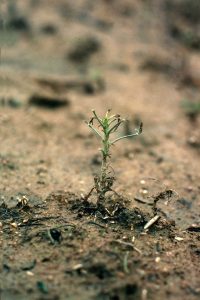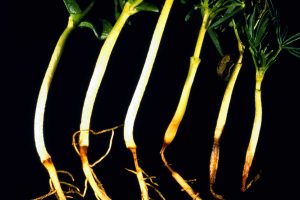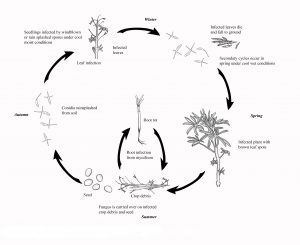The fungus Pleiochaeta setosa causes both brown leaf spot and Pleiochaeta root rot of lupins. Brown leaf spot is considered to be the most widespread foliar lupin disease in Australia. Severe outbreaks of brown leaf spot can cause total crop failure, but more often the disease reduces potential yields by 10-15 per cent. Implementing management strategies is essential to protect lupin crops as there are no treatments available post sowing for Pleiochaeta setosa.
What to Look For
Pleiochaeta setosa can cause both a root rot and foliage infection and can infect lupins at all stages of growth though seedling infection has the greatest impact on yield.
Pleiochaeta Root Rot
In the paddock wilted, weak or dying seedlings can be scattered throughout and will reduce stand density, plant vigour and yield. Incidence will be worse in paddocks with a close lupin rotation.
Plants will germinate normally, but severely affected seedlings will wilt and die displaying dark-brown or black lesions on the taproot that causes the root to rot. Less affected seedlings are weaker and smaller than healthy plants and root lesions can strip off the outer layer of tap roots that allows nodulation. After the 6 to 8 leaf stage the taproot thickens becoming less susceptible to infection. However, the finer lateral roots are susceptible for longer, which can result in reduced lateral root growth.
Brown Leaf Spot
Infected cotyledons initially develop dark brown spots and rapidly become yellow and drop off. Leaves develop discrete dark brown spots initially that eventually expand and take on a net-like appearance. Later, they can become distorted and reduced in size and under severe infection will drop off causing partial to complete defoliation. On stems, brown flecks may appear which can develop into large brown-black cankers which kill the stem above the infection point. Pods, especially those closer to the ground may develop larger brown lesions, resulting in seed infection. Stem and pod infections are usually associated with leaf infection in the upper canopy.

Typical brown leaf spot leaf lesions. These irregular shaped, brown spots are caused by Pleiochaeta setosa infection.

A badly defoliated lupin seedling. Leaves have dropped off due to severe infection by Pleiochaeta setosa.
Disease Cycle
The pathogen is carried over from one season to the next on previously infected plant material, in infested seed or as spores on the soil surface. Cultivation and sowing incorporate spores into the surface layer of soil where they remain dormant over summer. Spores survive through non-lupin crops though their populations decline over time. When the next lupin crop is sown, soil-borne spores germinate and infect the roots of lupin seedlings, causing Pleiochaeta root rot. Spores that have survived on the soil surface are splashed upwards by rain droplets, infecting leaves and stems and causing brown leaf spot; thus, continuing the disease cycle.
During the growing season large numbers of spores are produced when diseased leaves fall onto the soil surface. These spores start new infections through rain splash onto healthy foliage within a short period of time (4–5 days).
Seed-borne infections are important for dissemination of the pathogen over long distances and are responsible for initial infection in clean paddocks that are isolated from other lupin crops. Severely affected pods can contaminate seed lots. Once infection is established within the crop, secondary infection of other plant parts can occur by splash dispersal of fungal spores during rain.
Management
Brown leaf spot and root rot can be effectively controlled when an integrated approach to disease management is implemented. This involves using a number of strategies including crop rotations, seed dressings, resistant varieties and retaining cereal stubble.
Paddock Selection
Crop rotation is an important management strategy as the number of pleiochaeta spores in the soil is reduced by half for every year that a non-lupin crop or pasture is grown in the rotation. Reduced or minimum tillages operations reduce the incorporation of spores into the rooting zone of the soil profile. Long rotations are important so that lupin stubble will be decomposed before the next lupin crop is sown; avoid planting lupins in paddocks adjacent to lupin stubble.
Sowing
Deeper sowing places the emerging roots of lupins below the spores reducing the chances of pleiochaeta root rot. Sowing lupins into cereal stubble will reduce rain splash of spores onto lupin plants. The only other known host for brown leaf spot is serradella, a low yielding pasture legume which is not common in Victorian lupin areas.
Seed Treatment
Another important method for controlling Pleiochaeta setosa is to apply a fungicide seed dressing (containing ipodione or procymidone), although this only suppresses the disease and does not provide complete control, but it will reduce the transfer of the disease to the seedling and can reduce leaf drop by 50 per cent.
Resistant Varieties
Use resistant varieties. Variety selection is also an important management strategy. New narrow leaf lupin varieties (Lupinus angustifolius) have been released with resistance to pleiochaeta root rot and brown leaf spot. Broad leaf or Albus lupin (Lupinus albus) varieties are available with tolerance to brown leaf spot but can be susceptible to root rots under wet conditions and therefore, are limited to well-drained soils.




